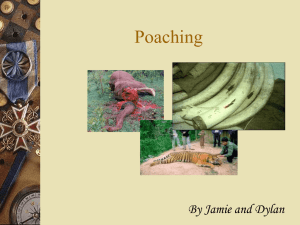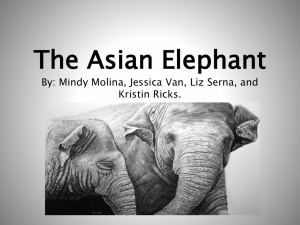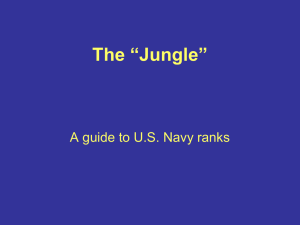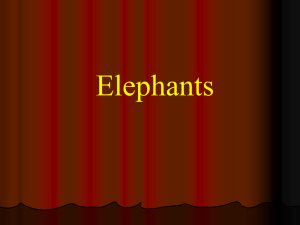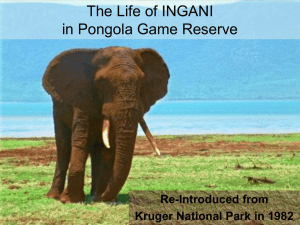Alles
advertisement
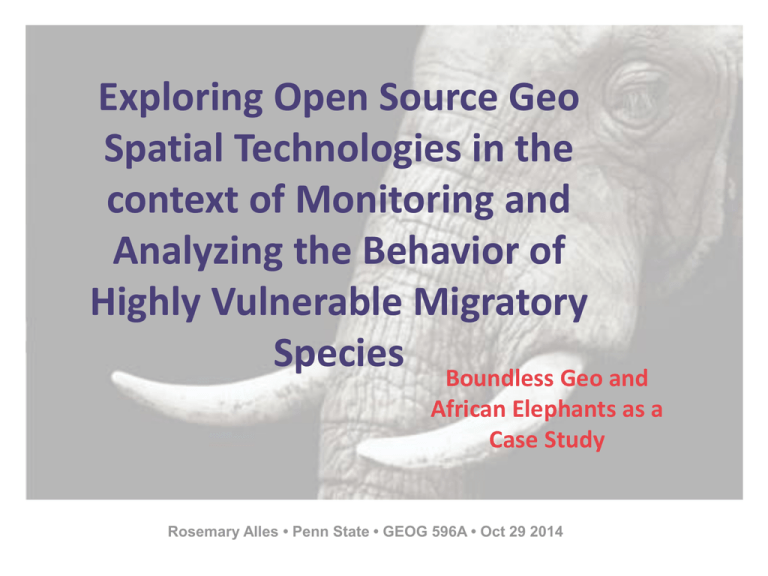
Exploring Open Source Geo Spatial Technologies in the context of Monitoring and Analyzing the Behavior of Highly Vulnerable Migratory Species Boundless Geo and African Elephants as a Case Study Rosemary Alles • Penn State • GEOG 596A • Oct 29 2014 Background: Elephants are Disappearing • WCS estimates historical populations may have exceeded 25 million individuals through the African continent. • In 1979 populations were estimated at ~1.3 million; Current counts are at ~400,000. • Causes – Poaching – HEC (Human Elephant Conflict) – Civil Unrest – Climate Change Background: Poaching Source: National Geographic http://ngm.nationalgeographic.com/2012/ 10/ivory/elephant-ivory-poaching-graphic Background: Poaching • Poaching is the most dramatic factor affecting elephant populations; 35,000+ elephants a year, ~96 a day and 1 every 15 minutes to satisfy the demand for ivory, primarily in Asia and largely in China for ivory “trinkets”; 70% of illegally poached ivory finds its way to China. • Rangers die along with elephants and increasingly wildlife trafficking, a ~$19 billion industry, sponsors terrorism. • Wittemyer et al: 2014 Study: Populations have reached a tipping point: "We are shredding the fabric of elephant society and exterminating populations across the continent." Background: In the first quarter of 2012, poachers traveled more than 1,000 kilometers (620 miles) on horseback from Sudan to reach northern Cameroon's Bouba Ndjida National Park, where they killed more than 300 elephants in two months. Source: STR/AFP/GETTY IMAGES In the first quarter of 2012, poachers traveled more than 1,000 kilometers (620 miles) on horseback from Sudan to reach northern Cameroon's Bouba Ndjida National Park, where they killed more than 300 elephants in two months. Background: Why does it Matter? • Ecological impacts from the loss of elephants are predicted to be serious. • A keystone species,dispensing seed,excavating water wells, architecting forests, savannas and deserts; a myriad species of endemic fauna and flora in African ecosystems depend on the survival of elephants. • Dr. Samuel Wasser from the Center of Conservation Biology, UW: – “They are environmental architects. They keep woods down in the savannah and are the most important dispersers of seeds of rain forest trees. The central African rain forest is the second most important area on earth for capturing carbon dioxide and storing it.” • Poaching sponsors terror. Background: Dzanga Bai in the CAR translated as village of the elephants, sees congregations of forest elephants in their family groups. Source: © Kalpesh Lathigra / WWF-UK Image: Dzanga Bai, translated as village of the elephants, sees congregations of elephants in their family groups. Geo Spatial Technologies as a Solution in Mitigating Poaching • Among current and emerging technologies addressing the crisis: – DNA tracking (Bio Spatial Tracking), – UAVs, – Mobile Devices/Apps – A slew of other Geo Spatial Technologies including GIS • Exploring Geo Spatial Technologies in the context of a flexible RTM capable of GIS is the focus of this project. DNA map (Bio Spatial Technologies) DNA: Fingerprinting confiscated stockpiles to their geographic source(s); identifying poaching hot spots. Sam Wasser at the UW is developing cutting edge DNA tracing technology. Geo Spatial Technologies as a Solution in Mitigating Poaching • UAVs: Drones in tracking wildlife, broadening surveillance capacity; equipped with cameras and sensors providing a birds eye view, and RTM through telemetry updates. Ground stations can be mobile, equipped with a simple laptop hosting GPS driven GIS and a communication system. The result is a dynamically updated thermal/optical map and corresponding analysis covering areas of interest. • Mobile Devices and Apps: Useful in the hands of rangers and the concerned public; hand held devices with corresponding (GIS) apps that permit the recording, reporting and tracking of wildlife crime. GIS enabled Drones in Conservation Source: http://www.tourismtattler.com/theeconomics-of-the-illegal-wildlife-trade/ A 3 step approach using drone spotter planes to combat animal poaching. Limitations in Current GIS in Monitoring Migratory Species • Open/closed source, inadequately supported, incompatible and distributed components, requiring time consuming integration and maintenance coupled with limitations in on-demand real-time analysis capabilities OR • High cost, proprietary, integrated GIS packages closed to source modification with steep learning curves and also with limitations in real-time on demand analysis capabilities. Need: Well Integrated GIS (and Geo Spatial Technologies) to Generate more than Location Maps • Although Current advances in technologies have made location based mapping or visualization through cloud based and non cloud-based GIS increasingly easier to achieve there is a need for seamlessly integrated GIS capable of the rapid assimilation of spatial data that provides functionality capable of rich statistical analysis as well as location based mapping/visualization in a feasible, functional and usable manner. Need: Well Integrated GIS (and Geo Spatial Technologies) to Generate more than Location Maps: need Analysis Useful in understanding spatiotemporal patterns and behavior of migratory species, enabling their conservation. – Migration (delineating transit corridors) (Pittiglio et al., 2011; Douglas-Hamilton, Krink & Vollrath, 2005; Osborn & Parker, 2003) – Home Range and Expansion (Ngene et al. 2010) – Behaviour (e.g. avoiding landmines in Angola (EWB); Human-elephant conflict (Sitati, 2003)) – Mitigating Poaching (Maingi et al 2012) Current Approaches: What’s Wrong with this Picture? Necessity or Choice? Source: Wall et al. 2014 Ecological Society of America Objective: A Boundless Prototype • Boundless (http://boundlessgeo.com/) formerly OpenGeo is an Open Source commercial modularized and complete geospatial platform for managing data and building maps and applications that can be integrated with the Rstatistical package. • The objective is to explore the usability of a proven, feasible and functional open source geospatial platform in the context of monitoring and studying the behavior of highly vulnerable migratory species; African elephants. • Boundless will be used to develop a prototype GIS application that has the potential to be used in a variety of contexts (cloud based, non-cloud based, mobile and fixed) for the conservation of elephants. Exploring Boundless as an Alternate GIS Platform for Analysis and Monitoring Applications: why Boundless? • Using the gauging parameters of functionality, power, costs and control over the package, Boundless makes the reasonable hypothesis that the value of a software system to a stakeholder can be expressed as: V = (F/O) * C • Where V = Value, F = Functionality and Power, O = Operational Costs and C = Control. Exploring Boundless: Value V = (F/O) * C V = Value, F = Functionality and Power, O = Operational Costs and C = Control. Boundless has been used and continues to be used successfully in Federal, State and International instances. http://boundlessgeo.com/ Source: Boundless 2014 Exploring Boundless: Architecture 1. Storage: Raw data needs to be managed in a relational database. OpenGeo Suite uses the PostGIS spatial database. 2. Application Server: The raw data needs to be accessed using web services, and rendered into cartographic products. OpenGeo Suite uses the GeoServer map/feature server. 3. Application Cache: Performance requires the caching of intermediate results, such as map files. OpenGeo Suite uses the GeoWebCache tile cache. 4. User Interface Framework: Targeted vertical applications serve one operational need and serve it well. OpenGeo Suite uses GeoExt/ExtJS as a platform independent user interface toolkit. 5. User Interface Map Component: Mapping applications need a map component that understands spatial features and map layers. OpenGeo Suite uses OpenLayers. Source: Boundless 2014 Exploring Boundless: What about R? • The R-statistical package can be integrated with the Boundless OpenGeo Suite through its component modules and libraries; for this project we will specifically explore the integration of the library adehabitat (http://cran.rproject.org/web/packages/adehabitat/index.html) • The adehabitat library provides four main components to analyze the spatiotemporal footprint of animals; management of raster maps, habitat selection/ecological niche analysis, home range estimation and analysis of animals’ trajectories. Statistical Analysis Capabilities Offered by R's adehabitat • Management of Raster Maps: import and export of raster maps to and from GIS, computing buffers around lines or points, identifying the value of environmental variables at a given spatial location, counting the number of points in a pattern in each pixel of a map and more. • Habitat Selection/Ecological Niche Analysis: functions allowing the analysis of habitat selection using tracking data, e.g. compositional analysis, eigenanalysis of selection ratios and K-select analysis. Statistical methods allowing the analysis of habitat selection available to wildlife ecologists; factor analysis, selection ratios, the Ecological niche factor analysis, the Mahalanobis distances and resources selection functions. • Home Range Estimation: home range estimation methods using tracking data; Minimum convex polygon, kernel estimation of the utilization distribution, the cluster home range and the nearest neighbor convex hull. • Analysis of Animals’ Trajectories: two types of trajectories are handled, one that does not include a temporal axis, type I, and one that does, type II. For type II descriptive parameters are automatically computed (turning angles, distance between successive relocations, mean squared displacement). Several other functions allow the management and analysis of trajectories, through these parameters (e.g. test of independent). A new partition algorithm is also underway which can partition animal trajectories into segments with homogeneous properties. Source: CRAN-R Project 2014 Functionality to be Prototyped through R’s adehabitat • Home Range Estimation. • Habitat Preference Estimation. • Predicting/Understanding behavior or changes in behavior (of elephants) in the context of rampant poaching: – What parameters are needed to understand and model this phenomena? I will perform a functionality needs assessment to determine what spatial and statistical methods will be required. – Reference to DNA maps, poaching hot spots, animals abandoning hot spots; use case: Botswana. Exploring Boundless: Data • This project will be using data captured by Project Field Trip Earth (http://www.fieldtripearth.org/). These are telemetered data and meta data relayed by GPS from collared elephants in Cameroon. • The data are in Excel, XML, KML, CSV and TXT file formats, and contain the following information: identity (of the animal and/or the collar), date/time the data point was received, location (longitude, latitude) in geographic coordinates and location code (LC). The location code determines the reliability of the GPS telemetry data for a given data point. • Additional contextual, meta and base layer data for Cameroon and vicinity will be obtained as needed; http://www.wri.org/our-work/project/congobasin-forest-atlases and http://www.gadm.org/ Architecture used in this Project’s Instantiation of a Boundless Prototype Data Receivers & APIs Data Receivers & APIs adehabitat RESULTS & TIMELINE • A working prototype. • A report on the feasibility, functionality and usability of using Boundless with R for the conservation of elephants; depending on the results, the report will include a section on the scalability of the prototype, accommodating other migratory species. • The prototype will be developed within the next 3 months, to be completed by the end of January 2015; a presentation about the project will be made at the SCGIS conference on July 26-29, 2015 in Monterey, California. References EWB (Elephants without Borders) http://www.elephantswithoutborders.org/downloadspapers/elephantslearn.pdf Douglas-Hamilton, I. (2012) Testimony of Iain DouglasHamilton Founder and CEO, Save the Elephants on Ivory and Insecurity: The Global Implications of Poaching in Africa before the Committee on Foreign Relations U.S. Senate. 2012. Douglas-Hamilton, I., S. Bhalla, G. Wittemyer & F. Vollrath (2006) Behavioural reactions of elephants towards a dying and deceased matriarch. Applied Animal Behaviour Science, 100, 87-102. Douglas-Hamilton, I. & F. Ihwagi (2010) Tracking Animals for Conservation Elephant Tracking Report No. 36. Douglas-Hamilton, I., Krink, T. & Vollrath, F. (2005) Movements and corridors of African elephants in relation to protected areas. Naturwissenschaften. 92: 158-163 George Wittemyer, Joseph M. Northrup, Julian Blanc, Iain Douglas-Hamilton, Patrick Omondi, and Kenneth P. Burnham (2014). Illegal killing for ivory drives global decline in African elephants. Proceedings of the National Academy of Sciences, 111(36) Graham, M. D., I. Douglas-Hamilton, W. M. Adams & P. C. Lee (2009) The movement of African elephants in a human-dominated land-use mosaic. Animal Conservation, 12, 445-455. Maingi, J. K., J. M. Mukeka, D. M. Kyale & R. M. Muasya (2012) Spatiotemporal patterns of elephant poaching in south-eastern Kenya. Wildlife Research, 39, 234-249. Ngene, S. M., H. Van Gils, S. E. Van Wieren, H. Rasmussen, A. K. Skidmore, H. H. T. Prins, A. G. Toxopeus, P. Omondi & I. DouglasHamilton (2010) The ranging patterns of elephants in Marsabit protected area, Kenya: the use of satellite-linked GPS collars. African Journal of Ecology, 48, 386-400. Osborn, E.V., & Parker, G.E. (2003) Linking two elephant refuges with a corridor in the communal lands of Zimbabwe. African Journal of Ecology, 41,68-74 Pittiglio, C., Skidmore, A.K., van Gils, H.A.M.J. and Prins, H.H.T. (2011) Identifying transit corridors for elephant using a long time-series. International Journal of Applied Earth Observation and Geoinformation. 14:61-72 Sitati, N. W. & M. J. Walpole (2006) Assessing farm-based measures for mitigating human-elephant conflict in Transmara District, Kenya. Oryx, 40, 279-286. Sitati, N. W., M. J. Walpole, R. J. Smith & N. Leader-Williams (2003) Predicting spatial aspects of human-elephant conflict. Journal of Applied Ecology, 40, 667-677. Thomas, B. 2010. An application of satellite tracking technologies to conserve wildlife. In Natural Resource Management. Palmerston North, New Zealand: Massey University. Thomas, B., J. D. Holland & E. O. Minot (2012) Seasonal home ranges of elephants (Loxodonta africana) and their movements between Sabi Sand Reserve and Kruger National Park. African Journal of Ecology, 50, 131-139. Wall, J., Wittemyer, G., Klinkenberg B., Hamilton, I. D. (2014) Novel opportunities for wildlife conservation and research with real-time monitoring. Ecological Applications, 24(4), 593–601. Wasser, S., B. Clark & C. Laurie (2009) The ivory trail. Scientific American, 301, 68-76. Wasser, S., J. et al. (2010) Conservation. Elephants, ivory, and trade. Science, 327, 1331-2. Wasser, S. K., A. M. Shedlock, K. Comstock, E. A. Ostrander, B. Mutayoba & M. Stephens (2004) Assigning African elephant DNA to geographic region of origin: applications to the ivory trade. Proc Natl Acad Sci U S A, 101, 14847-52.
